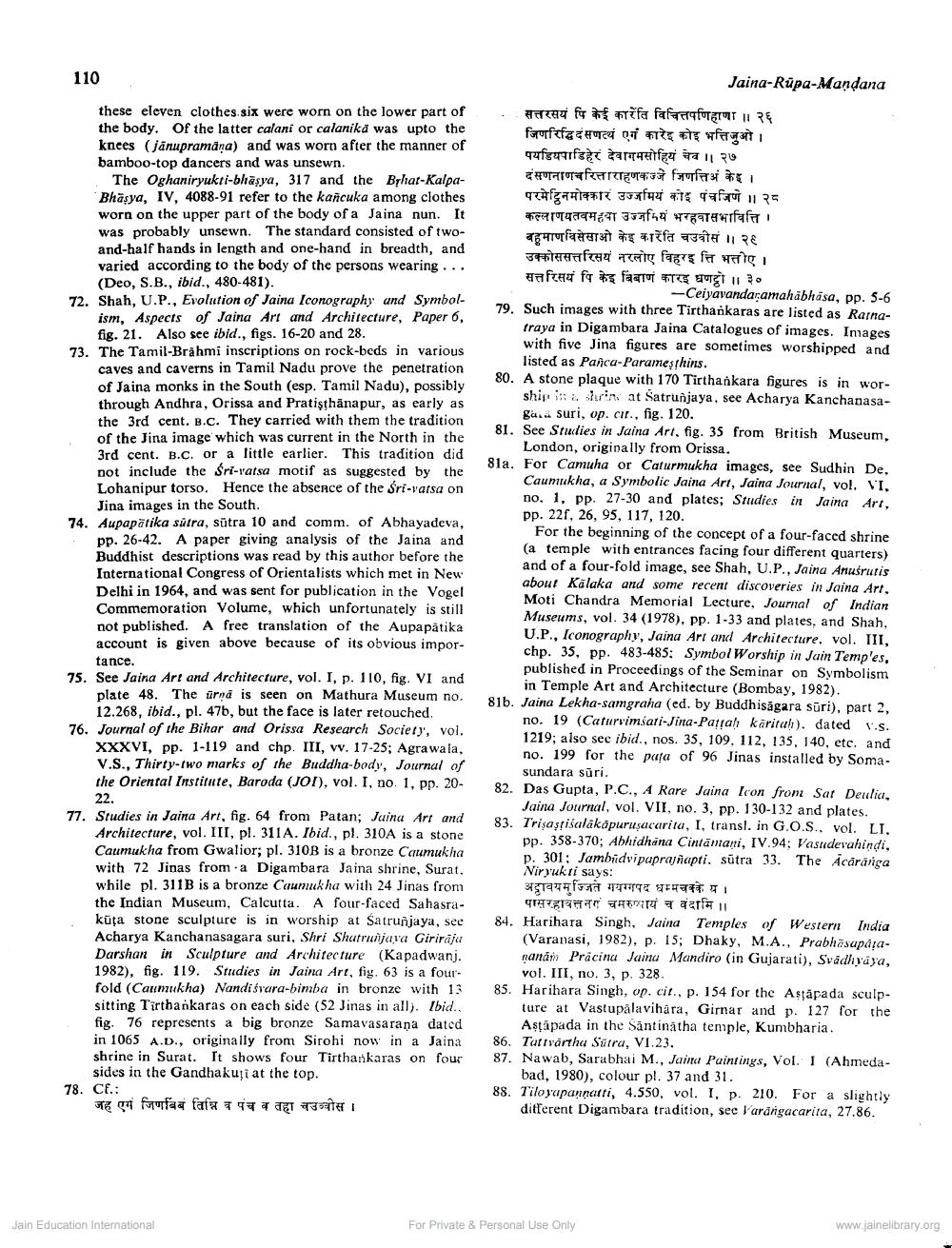________________
110
Jaina-Rupa-Mandana
these eleven clothes six were worn on the lower part of the body. Of the latter calani or calanika was upto the knees (janupramāna) and was worn after the manner of bamboo-top dancers and was unsewn.
The Oghaniryukti-bhasya, 317 and the Byhat-KalpaBhāsya, IV, 4088-91 refer to the kañcuka among clothes worn on the upper part of the body of a Jaina nun. It was probably unsewn. The standard consisted of twoand-half hands in length and one-hand in breadth, and varied according to the body of the persons wearing ...
(Deo, S.B., ibid., 480-481). 72. Shah, U.P., Evolution of Jaina Iconography and Symbol
ism, Aspects of Jaina Art and Architecture, Paper 6,
fig. 21. Also see ibid., figs. 16-20 and 28. 73. The Tamil-Brahmi inscriptions on rock-beds in various
caves and caverns in Tamil Nadu prove the penetration of Jaina monks in the South (esp. Tamil Nadu), possibly through Andhra, Orissa and Pratişthānapur, as early as the 3rd cent. B.C. They carried with them the tradition of the Jina image which was current in the North in the 3rd cent. B.c. or a little earlier. This tradition did not include the Sri-vatsa motif as suggested by the Lohanipur torso. Hence the absence of the Sri-vatsa on
Jina images in the South. 74. Aupapātika sätra, sūtra 10 and comm. of Abhayadeva,
pp. 26-42. A paper giving analysis of the Jaina and Buddhist descriptions was read by this author before the International Congress of Orientalists which met in New Delhi in 1964, and was sent for publication in the Vogel Commemoration Volume, which unfortunately is still not published. A free translation of the Aupapatika account is given above because of its obvious impor
tance. 75. See Jaina Art and Architecture, vol. I, p. 110, fig. VI and
plate 48. The irá is seen on Mathura Museum no.
12.268, ibid., pl. 47b, but the face is later retouched. 76. Journal of the Bihar and Orissa Research Society', vol.
XXXVI, pp. 1-119 and chp. III, v. 17-25; Agrawala,
V.S., Thirty-two marks of the Buddha-body, Journal of the Oriental Institute, Baroda (JOI), vol. I, no. 1, pp. 20
22. 77. Studies in Jaina Art, fig. 64 from Patan; Jaina Art and
Architecture, vol. III, pl. 311A. Ibid., pl. 310A is a stone Caumukha from Gwalior; pl. 310B is a bronze Caumukha with 72 Jinas from a Digambara Jaina shrine, Surat. while pl. 311B is a bronze Caumukha with 24 Jinas from the Indian Museum, Calcutta. A four-faced Sahasraküța stone sculpture is in worship at Satrunjaya, see Acharya Kanchanasagara suri, Shri Shatrunjava Giriraju Darshan in Sculpture and Architecture (Kapadwanj. 1982), fig. 119. Studies in Jaina Art, fig. 63 is a fourfold (Caumukha) Nandi svara-bimba in bronze with 13 sitting Tirthankaras on each side (52 Jinas in all). Ibid., fig. 76 represents a big bronze Samavasarana dated in 1065 A.D., originally from Sirohi now in a Jaina shrine in Surat. It shows four Tirthankaras on four
sides in the Gandhakuļi at the top. 78. Cf.:
जह एग जिबिंब तिन्नि व पंच व तहा चउच्चीस ।
सत्तरसय पि केई कारेंति विचित्तपणिहाणा ॥ २६ जिणरिद्धिदसणत्थं एग कारेइ कोइ भत्तिजुओ। पयडियपाडिहेरं देवागमसोहियं चेव ।। २७ दसणनाणचरित्ताराहणकज्जे जिणत्ति केह । परमेट्रिनमोक्कार उर्जामयं कोई पंचजिणे ॥ २८ कल्लाणयतवमहया उज्जयिं भरहवासभावित्ति । बहुमाणविसेसाओ केइ कारेंति चउवीसं ।। २६ उक्कोससत्तरिसय नरलोए विहरइ त्ति भत्तीए । सत्तरिसयं पि केइ बिबाण कारइ धणटो ।। ३०
-Ceiyavandaramahābhāsa, pp. 5-6 79. Such images with three Tirtharkaras are listed as Rarna
traya in Digambara Jaina Catalogues of images. Images with five Jina figures are sometimes worshipped and
listed as Panca-Parameşthins. 80. A stone plaque with 170 Tirthankara figures is in wor
ship in a suin at Satrunjaya, see Acharya Kanchanasa
gausu suri, op. cit., fig. 120. 81. See Studies in Jaina Art, fig. 35 from British Museum,
London, originally from Orissa. 81a. For Camuha or Caturmukha images, see Sudhin De.
Caumukha, a Symbolic Jaina Art, Jaina Journal, vol. VI. no. 1, pp. 27-30 and plates; Studies in Jaina Art, pp. 226, 26, 95, 117, 120.
For the beginning of the concept of a four-faced shrine (a temple with entrances facing four different quarters) and of a four-fold image, see Shah, U.P., Jaina Anusrutis about Kalaka and some recent discoveries in Jaina Art, Moti Chandra Memorial Lecture, Journal of Indian Museums, vol. 34 (1978), pp. 1-33 and plates, and Shah, U.P., Iconography, Jaina Art and Architecture. vol. III, chp. 35, pp. 483-485; Symbol Worship in Jain Temples, published in Proceedings of the Seminar on Symbolism
in Temple Art and Architecture (Bombay, 1982). 81b. Jaina Lekha-samgraha (ed. by Buddhisăgara sūri), part 2,
no. 19 (Caturvimšati-Jina-Patah karital). dated vis. 1219; also see ibid., nos. 35, 109, 112, 135, 140, etc. and no. 199 for the pata of 96 Jinas installed by Soma
sundara sūri. 82. Das Gupta, P.C., A Rare Jaina Icon from Sat Deulia,
Jaina Journal, vol. VII, no. 3, pp. 130-132 and plates. 83. Trişastišalakāpuruşacarita, I, transl. in G.O.S.. vol. LI.
pp. 358-370; Abhidhana Cintamani, IV.94; Vasudevahindi, p. 301: Jambidvipaprajnapti. sutra 33. The Acaränga Niryukti says: अट्टावय मुज्जिते गयग्गपद धम्मचक्के य ।
पासरहाक्त्तनग चमरुपायं च वदामि ।। 84. Harihara Singh, Jaina Temples of Western India
(Varanasi, 1982), p. 15; Dhaky, M.A., Prabhasapaananán Pracina Jaina Mandiro (in Gujarati), Svadhyaya,
vol. III, no. 3, p. 328. 85. Harihara Singh, op. cit., p. 154 for the Astăpada sculp
ture at Vastupalavihara, Girnar and p. 127 for the
Astăpada in the Säntinátha temple, Kumbharia. 86. Tattvärtha Sutra, VI.23. 87. Nawab, Sarabhai M., Jaina Paintings, Vol. I (Ahmeda
bad, 1980), colour pl. 37 and 31. 88. Tiloyapannatti, 4.550, vol. I, p. 210. For a slightly
different Digambara tradition, see larangacarita, 27.86.
Jain Education International
For Private & Personal Use Only
www.jainelibrary.org




